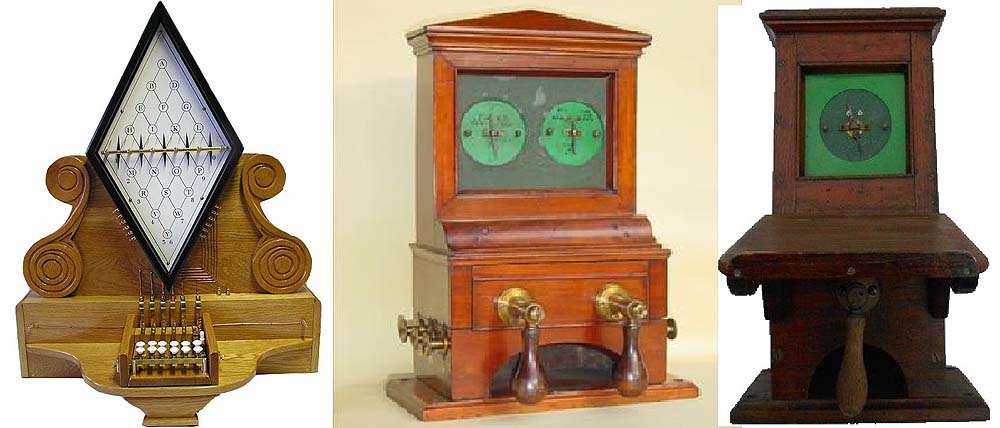|
|
 |
 |
|
Stations, Junctions, etc
Engine Sheds
Other
|

|
Miscellaneous: Operating Equipment & Practices
Signalling Procedure: misc_equip254
 |
William Fothergill Cooke recognised the potential of the
telegraph in 1836 and with help from the outstanding academic Professor Charles
Wheatstone developed and patented (No 7390) a five-needle telegraph instrument
in the following year (see replica instrument in left photograph). This was
trialled for a six month period on the LNWR between Euston and Camden Town,
while an ‘improved’ four-needle instrument was installed on the Great
Western Railway in 1839 between Paddington and West Drayton at the quoted cost
of £165 per mile for the circuit, £30 for each station and
£48 for each instrument (subsequently the circuit costs for this 13 mile
conduit containing four rubber coated copper wires was reported as costing
£287 per mile). Two intermediate stations at Ealing and Hanwell were also
added to compensate for the signal attenuation along the route, but the system
quickly fell out of use. This telegraph line was later extended a further four
miles to Slough in 1842 using a cheaper two wire overhead (a pair of zinc
coated iron wires supported by tall cast iron poles) system and two-needle
instruments were installed (see centre photograph).
In 1843 Prof Wheatstone assigned his patent rights to Mr
Cooke in exchange for royalties and in 1845 a syndicate, which included Mr
Cooke purchased all the Cooke and Wheatstone patents and created the Electric
Telegraph Company (ETC). By 1847 the ETC had installed a number of telegraph
circuits alongside several railway lines and was charging the railway companies
for their use. These were connected to single-needle instruments (see right
photograph), but in 1851 the original patents expired and other competing
Telegraph Companies emerged, allowing the Railway Companies to renegotiate
charges on more favourable terms. In particular the ETC had to start paying for
circuit wayleaves and to reduce these costs, they usually offered the free use
of the telegraph system for railway signalling purposes in exchange for the
circuit wayleaves. There consequently followed a rapid expansion in the
telegraph circuits along all railway routes to the major cities. For example,
in 1850 the Great Western Railway only had 19 miles of telegraph circuit; with
one instrument at Paddington and a second at Slough, but by the end of 1854
this had grown to 1,952 miles of telegraph circuit with 102 instruments (with a
further 1,614 miles of telegraph circuit with 115 instruments on Railway
companies which would later be absorbed by the Great Western Railway). For more
information on the ETC and development of the telegraph system see 'misc_equip255.'.
Robert Ferris
 back back

|
|
|
